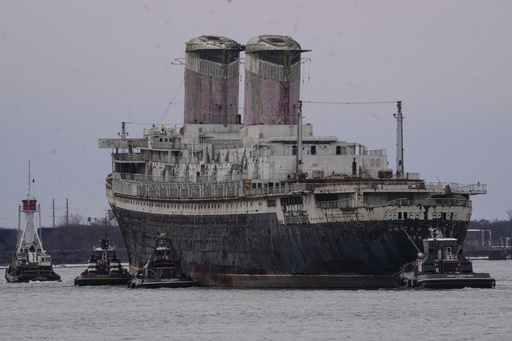The historic ocean liner, which is set to be transformed into the largest artificial reef in the world, embarked on its final journey from the Delaware River waterfront in south Philadelphia on Wednesday. The SS United States, measuring 1,000 feet in length and once known for breaking transatlantic speed records, is being towed to Mobile, Alabama. There, the ship will undergo preparations before it is ultimately sunk off the coast of Florida.
This development follows a resolution to a long-standing rent disagreement between the conservancy responsible for the vessel and its landlord, occurring about four months ago. Although there were initial plans to move the ship last November, the timeline was postponed due to stability concerns raised by the U.S. Coast Guard regarding the vessel’s readiness for the journey.
Local officials in Okaloosa County, located in Florida’s Panhandle, envision the SS United States as a remarkable addition to the county’s extensive network of over 500 artificial reefs. They anticipate that the ship will become a popular diving site, potentially attracting significant revenue for the local economy through scuba shops, charter fishing operations, and nearby hotels.
The cost of acquiring and transforming the ship is projected to exceed $10 million, with the overall process—including cleaning, transport, and sinking—expected to take at least one and a half years. Once considered a triumph of American engineering and design, the SS United States served a dual purpose as a military vessel capable of transporting thousands of troops.
On its inaugural voyage in 1952, the ship set a remarkable transatlantic speed record, averaging 36 knots, equivalent to over 41 mph. It completed the crossing of the Atlantic Ocean in a record-breaking time of three days, 10 hours, and 40 minutes, surpassing the previous record held by the RMS Queen Mary by 10 hours. To this day, the SS United States maintains the title for the fastest transatlantic voyage by an ocean liner.
Susan Gibbs, president of the SS United States Conservancy and the granddaughter of the ship’s naval architect, remarked on the historical significance of the vessel, stating, “The ship will forever symbolize our nation’s strength, innovation, and resilience. We wish her ‘fair winds and following seas’ on her historic journey to her new home.”
After being classified as a reserve ship in 1969, the SS United States changed hands several times among private owners who aimed to revitalize it. However, due to financial constraints and misaligned timing, these aspirations ultimately fell through, leaving the vessel idle for years along the Philadelphia waterfront.




